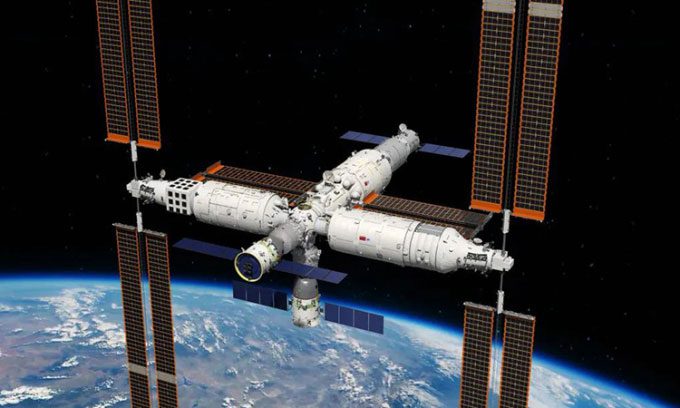The Tiangong Space Station features a T-shaped design with 3 modules, providing a total living space of over 110m3 and accommodating 6 astronauts.
Following the successful launch of the Shenzhou 14 crewed spacecraft on June 5, China is rapidly advancing towards establishing the Tiangong Space Station as a national space laboratory, CGTN reported on June 12.
From the core module Tianhe orbiting Earth, the space station will expand into a T-shaped structure with Tianhe at the center and two laboratory modules, Wentian and Mengtian, on either side.
Wentian is scheduled for launch in July, while Mengtian is set to launch in October. Once these two modules become operational, the space station will have a total living space exceeding 110m3, featuring 6 sleeping quarters and 2 bathrooms, sufficient for 6 astronauts. A total of 25 scientific experiment cabinets will be installed across the 3 modules. Each cabinet will function like a mini-laboratory capable of supporting experiments.
The Tiangong Space Station is expected to operate in low Earth orbit at an altitude of approximately 340 – 450 km above the Earth’s surface. The design lifespan of this facility is 10 years, but experts believe it could function for over 15 years with proper maintenance.

Simulation of the basic 3-module structure of China’s space station. (Photo: CMG)
Tianhe Core Module
The Tianhe core module was launched into orbit in April 2021 and serves as the command and management center of the space station. It provides thrust to maintain the station’s orbit and controls the internal working conditions. With a length of 16.6 m, a maximum diameter of 4.2 m, and a launch weight of 22.5 tons, it is the largest spacecraft ever developed by China.
Tianhe offers approximately 50 m3 of living space, serving as the main living area for astronauts. They can also conduct scientific experiments here. A total of 6 Chinese astronauts from two separate missions have lived and worked in this module, returning safely to Earth afterward.
The 3 crew members of Shenzhou 12 were the first to arrive at Tianhe, working there from June to September last year. The Shenzhou 13 crew entered the core module in October 2021 and returned to Earth in April 2022, setting a new record for China’s space flight duration—182 days.
Tianhe is equipped with two docking ports to connect with the two laboratory modules and 3 docking ports for cargo, crewed spacecraft, or other spacecraft. The core module also features an airlock for astronauts to conduct extravehicular activities.
Wentian Laboratory Module
The two laboratory modules are similar in size and weight to the core module, although China has not disclosed many additional details.
Wentian is primarily dedicated to research in space life sciences. It is equipped with experiment cabinets that can support experiments related to life, ecology, biotechnology, as well as comparative studies of biological growth mechanisms under various gravitational conditions.
Additionally, the experiment cabinets can be used to study the growth, development, genetics, and aging of plants, animals, and microorganisms in space, as well as research on closed ecosystems.
The scientific equipment within the module also allows for multi-level biological experiments at the molecular, cellular, tissue, and organ levels using various probing methods, such as visible light, fluorescence, and microscopy.
Mengtian Laboratory Module
The Mengtian laboratory module is mainly intended for research in microgravity science. This module is equipped with experiment cabinets for various fields such as fluid physics, materials science, combustion science, fundamental physics, and aerospace technology.
The world’s first cold atom clock in space, including hydrogen clocks, rubidium clocks, and optical clocks, will be installed on Mengtian. They are expected to form a time and frequency system with the highest accuracy and frequency stability in space, serving scientific research such as gravitational redshift or measuring fine structure constants.
As the International Space Station (ISS) is expected to cease operations in the coming years, Tiangong may become the only operational space station. The China National Space Administration (CNSA) has expressed a willingness to cooperate internationally and allow non-Chinese astronauts to participate in future missions aboard the station.





















































